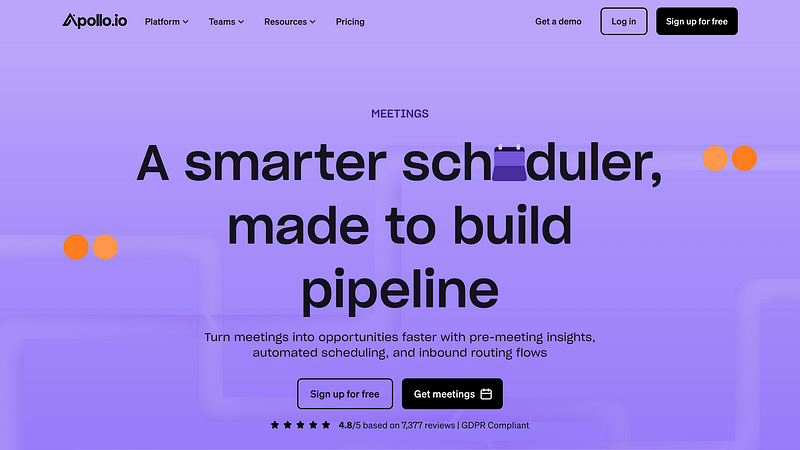Enhancing Website Traffic With Apollo.io and Webflow
A Guide to Effective SEO Practices and Outbound Marketing

Having a stunning Webflow site is a great start, but without a steady stream of visitors, that beautiful design can go unnoticed. By focusing on effective SEO practices for Webflow sites alongside Apollo.io outbound marketing strategies, you can strike the perfect balance between inbound and outbound tactics. In this article, we’ll dive into Webflow SEO best practices, explain how to leverage Apollo.io lead generation strategies, and show you how integrating Webflow with Apollo.io for marketing can give your business a significant boost in traffic and conversions.
1. Laying the Foundation: Webflow SEO Best Practices
1.1 Optimize Your Site Structure
Optimizing Webflow sites for search engines starts with a solid site structure. This means organizing your pages logically (e.g., “Services,” “About,” “Blog”) and using descriptive URLs that reflect the page content. Webflow allows you to customize URLs easily, so take advantage of that feature to help both users and search engines navigate your site better.
Pro Tip: Use keywords in your URLs (e.g., yoursite.com/webflow-seo-tips) instead of random strings of letters or numbers.1.2 Master Your Meta Tags
While meta tags (titles and descriptions) may seem old-school, they’re still incredibly important for Webflow SEO optimization techniques. When someone sees your site’s title and description on a search engine results page (SERP), that’s often their first impression.
- Titles: Keep them concise, clear, and keyword-rich.
- Descriptions: Provide a quick summary that entices users to click.
Example
Title: “Webflow SEO Best Practices: A Guide to Higher Rankings”
Description: “Discover how to optimize your Webflow site for search engines and attract the right audience.”
1.3 Speed It Up
Site speed is a crucial factor in modern SEO. Luckily, Webflow offers hosting that’s already optimized for speed. To maintain fast load times:
- Compress and resize your images before uploading.
- Use Webflow’s built-in responsive images feature.
- Keep an eye on third-party scripts and external embeds, which can bog down performance.
1.4 Publish Valuable Content
Search engines want to serve relevant, high-quality content to users. Posting regular blog articles, tutorials, and videos that address your audience’s challenges can make your site more visible in organic search results. Focus on topics that resonate with your target customers and naturally include your chosen keywords.
2. Taking Action: Apollo.io Outbound Marketing Strategies
While great SEO can help people find you organically, it can take time. Apollo.io outbound marketing strategies fill that gap by allowing you to actively reach out to your ideal audience.
2.1 Apollo.io Lead Generation Strategies
The power of Apollo.io lies in its robust prospecting and lead generation features. You can filter potential leads based on criteria like job title, industry, and location. This targeted approach lets you connect with people who are most likely to benefit from your services or products.
Example Use Case: You run a design agency specializing in e-commerce stores. Using Apollo.io, you filter prospects by “e-commerce manager” or “online retail CEO,” ensuring you reach the right decision-makers.
2.2 Personalize Your Outreach
Outbound marketing can sometimes feel impersonal if it’s not done right. Apollo.io email outreach best practices emphasize personalization to make your messages stand out. Reference something specific about the prospect’s industry, company size, or latest social media post to create an authentic connection.
Quick Tip: Include a link to a helpful article on your Webflow blog. For instance, “I recently published an in-depth guide on improving e-commerce site conversions — thought you might find it useful.”
2.3 Automate for Efficiency (But Stay Human)
Apollo.io lets you automate follow-up emails, saving you time. Create a sequence:
- Day 1: Introduction email
- Day 3: “Just checking in” follow-up
- Day 7: “Thought you might also like this resource”
While automation is a lifesaver, don’t forget to add a personal note in each template. A simple mention of a prospect’s recent LinkedIn post or a personalized greeting can make a world of difference.
3. Integrating Webflow With Apollo.io for Marketing
3.1 Centralize Your Data
Integrating Webflow with Apollo.io for marketing efforts means your leads and site visitors can sync in one place. You can use a tool like Zapier to connect Webflow forms to Apollo.io. Whenever someone fills out your “Contact Us” or “Newsletter Sign-Up” form, that info flows directly into your Apollo.io account.
Why This Matters: You’ll never lose track of potential leads, and you can start an outbound campaign immediately — while the lead is still warm.
3.2 Track Engagement
After hooking up your systems, you can track which outbound efforts lead people to specific pages on your Webflow site. Combining Webflow’s site analytics with Apollo.io’s engagement metrics gives you a big-picture view of what’s actually driving traffic and conversions.
- High Bounce Rates? Maybe your landing page needs a clearer call-to-action.
- Low Open Rates on Emails? Time to tweak your subject lines or scheduling.
3.3 Build a Feedback Loop
As you observe how site visitors behave (e.g., which blog posts they read, how long they stay on a page), funnel that insight back into your Apollo.io outreach. If a particular post on your Webflow blog is generating lots of traffic, reference it in future cold emails or share it in follow-ups.
4. Driving Website Traffic Using Apollo.io and SEO: The Perfect Blend
4.1 Inbound + Outbound
Inbound methods — like Webflow SEO optimization techniques — are ideal for long-term growth and building authority in your niche. Outbound efforts — like Apollo.io outbound marketing strategies — let you proactively connect with potential leads.
Think of these approaches as complementary:
- Inbound: Attracts those already searching for solutions you offer.
- Outbound: Targets those who may not know they need your solution yet.
4.2 Ongoing Optimization
SEO is an ongoing game. Keep an eye on Google’s algorithm changes, your keyword rankings, and your audience’s shifting interests. Simultaneously, refine your Apollo.io campaigns by adjusting criteria, personalizing your outreach, and testing new messaging angles.
Conclusion
Building a successful online presence doesn’t happen overnight, but by enhancing website traffic with Apollo.io and Webflow, you can significantly speed up the process. Start by optimizing your Webflow site for search engines — think fast load times, strategic keywords, and high-quality content. Then, layer on Apollo.io email outreach best practices to connect with your ideal audience directly.
The goal is to create a self-sustaining loop: as your SEO improves, more visitors discover your site, sign up for your offers, and become warm leads in Apollo.io. Meanwhile, your outbound strategy drives targeted prospects to your site, boosting engagement and conversions. This powerful combination ensures your Webflow website is more than just a pretty face — it’s a dynamic marketing and sales engine.





